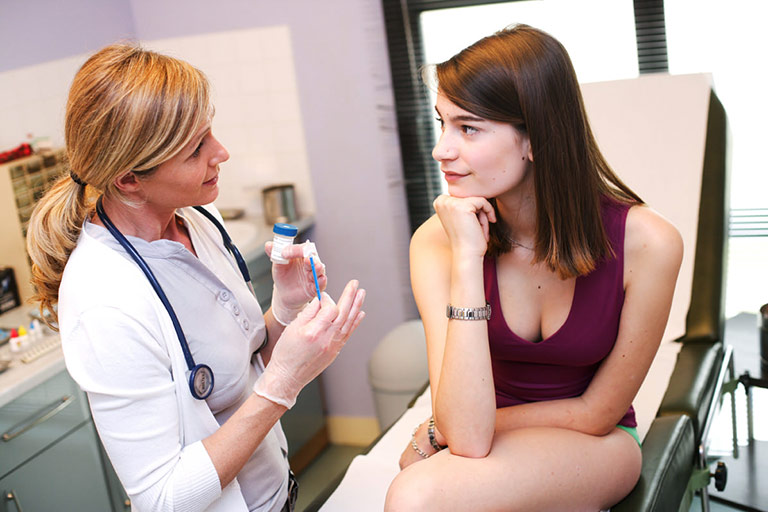
You may have been told by your health care provider (HCP) that your Pap test results were abnormal. Maybe you’re worried and wondering what this means and how it will affect you. Knowing the possible reasons for abnormal results will help.
What is a Pap test?
A Pap test, also called a “Pap smear,” is often part of a pelvic exam. The word “Pap” is short for Papanicolaou, which is the last name of the doctor who studied changes in cervical cells. A Pap test is usually done at age 21 unless you have special risks such as immune problems or HIV. It’s the only way to check the cells on your cervix for changes that can lead to cancer. Your provider will usually check for STIs (sexually transmitted infections) such as chlamydia and gonorrhea at the same time (if you are <25 years old or have risks for STIs).
How is a Pap test done?
As part of your pelvic exam, your provider will take a thin plastic wand and a tiny brush and gently wipe away some of the cells from your cervix. Most girls don’t feel anything at all. A few girls may feel a little cramping as their cervix is gently brushed. If you feel anything, it usually lasts less than 1 minute. These cells are placed in a bottle or on a glass slide and sent to a laboratory.
A trained technician then examines the sample of cells under a microscope to see if the cells are normal, or if there are any problems. The lab then gives the results to your health care provider, who will give you the results.
I’ve been told I have an abnormal Pap. Does it mean I have cancer?
No. Cancer is usually not the reason why your Pap test is abnormal. The most common reason for an abnormal Pap test is a vaginal or cervical infection that causes changes in the cells of your cervix. Most of these changes can be followed closely until they return to normal. Often, your body will clear the HPV infection that caused the changes all by itself. Sometimes special treatments are needed. Regular Pap tests and treatment, if needed, can prevent most types of cervical cancer.

What does my Pap test result really mean?
Although most Pap tests come back as normal, it’s not unusual for the test results to be abnormal if you are a young woman.
The following words explain Pap test results:
- Normal – This means that your cervix is healthy. Your provider will tell you when you need your next Pap test.
- Unsatisfactory – For some reason the sample of cells was not a good sample and can’t be read by the lab technician. Your provider will let you know when the Pap test needs to be repeated.
- Benign changes – This means that your Pap test was basically normal. However, you may have an infection that is causing inflammation of the cervical cells. You may need a pelvic exam to check for the cause of the infection and prescribe treatment if needed. Ask when you should have your next Pap test.
- ASCUS – (which is short for “Atypical Squamous Cells of Undetermined Significance”) This simply means there are some funny looking cells on the test and more tests may be done to figure out if HPV (human papillomavirus) is the reason for the changes.
If you are healthy and your Pap shows ASCUS, your provider may recommend an HPV test, a repeat Pap in a year or colposcopy. You will need to have your Pap test repeated in one year. If the test (at the one year mark) is still abnormal you may need a colposcopy.
The following guidelines are for young women who are 24 years of age or younger:
- ASC-H – This result means that the cervical cells are not the typical cells that are found on the cervix. They are most likely related to HPV. They are considered “atypical cells.” The “H” at the end of this abbreviation means that there is a possibility that “high-grade changes” may be the cause of the problem. If this is your Pap test result, you will need to have a colposcopy.
- LSIL (Low Grade Squamous Intraepithelial Lesion) – This result usually means that you have been infected with the human papillomavirus (HPV). You will be asked to return in 12 months for a repeat Pap test or you may be referred for a colposcopy. If the repeat Pap test comes back abnormal, you will need to follow up in 12 months for another repeat Pap test. Depending on those results, you may be referred for colposcopy or go back to your normal screening of every three years.
- HSIL (High Grade Intraepithelial Lesion) – This result means that the cells on your cervix have changed. The results are more serious than low-grade changes. You likely do not have cancer now, but without treatment you are at risk for developing cervical cancer. Treatment can prevent this. You will need a colposcopy.
- AGC (Atypical Glandular Cells) – This result means that there are changes in the glandular cells of the cervix. You will need a colposcopy.
- Cancer – Although this is very rare in young women, if your Pap test comes back showing cancer cells, you need to be seen by a gynecologist who specializes in patients with cancer (oncologist). Treatment is necessary right away and usually includes surgery. The earlier the treatment, the better your chances are of staying healthy.
If your provider tells you that you have LSIL or HSIL on your colposcopy test, you will need to see your colposcopy specialist for follow-up visits.
What if I need a repeat Pap test?
Your provider will decide if and when you need to have your Pap test repeated.
If the Pap test is going to be repeated, you should:
- Schedule your appointment after any vaginal or cervical infection, yeast infection, or STI has been treated (wait 2 weeks after your last dose of medicine).
- It is best to have a Pap test when you are not on your period, however it can be done if you have light bleeding. If your period is moderate to heavy, call your provider’s office to check if you should reschedule your Pap test.
- Tell your provider if you think you might be pregnant.
- Tell your provider if you have any other health conditions or allergies.
What can I expect if I need a colposcopy?
After the nurse asks questions (for example: “When was your last period?”), and gives you information about what to expect, you will be given a hospital gown to wear and be asked to remove your clothing from the waist down. Your provider will then speak with you, and have you sign a consent form for the procedure. You will then lie down on the exam table and place your feet in foot holders (the same position as a pelvic exam). Next, the colposcopy specialist will gently insert a speculum (just like when you have your Pap test) into your vagina in order to separate the vaginal walls so your cervix can be seen easily. The colposcope is a magnifying tool that is placed near the opening of your vagina. Your doctor will be able to see your cervix through the magnifying lens.
It might make you feel better to know that the colposcope is only placed at the outside of your vagina and does not touch you. It’s similar to a large magnifying glass that helps your provider see the tiny cells on your cervix. Next, your cervix and vagina will be swabbed with a vinegar solution. The solution temporarily causes the unhealthy cells to change color, so they can be easily seen. If there are unhealthy appearing cells, it’s likely that your colposcopy specialist will do a biopsy. This is when a tiny sample of tissue (much smaller than ¼ of the size of a pencil eraser) is removed with an instrument similar to a pair of tweezers. The tissue sample is then placed in a jar with a preservative liquid and is sent to the lab to be checked out.
What can I expect during a colposcopy?
The colposcopy itself usually isn’t uncomfortable. It’s really a long pelvic exam and a way to examine your cervix. A biopsy, sometimes done at the time of a colposcopy, may be a bit uncomfortable, but this part takes less than one minute. When the tiny tissue sample is removed, some young women feel nothing, while others describe a “pinching” feeling or “mild cramps.” You may be told to take an over the counter pain reliever such as ibuprofen or naproxen sodium before the procedure to help decrease any discomfort you may have. This is especially helpful if you tend to have menstrual cramps or if you have discomfort when you have a Pap test. Ask about taking the medicine that you usually take for menstrual cramps. The entire colposcopy procedure takes about 15-20 minutes.

What happens after the colposcopy is over?
After the colposcopy, your colposcopy specialist will explain what he or she saw through the high powered lens and if a sample of tissue was taken. It usually takes about 2-3 weeks for the results of the biopsy to be ready. Make sure to make a follow-up appointment and give the scheduler your correct phone number so he or she can contact you.
- It’s common to have slight bleeding or spotting that lasts a few days after the biopsy.
- Use pads (not tampons) for any bleeding you might have.
- You may see brownish material or clumps along with blood on your underwear or pad. This is not tissue. This is from a certain kind of solution that is used to control bleeding, called “Monsel’s.” The brownish clumps will last about 1 to 5 days.
- It’s even possible to have a “blackish discharge” if the health care provider used a solution called “silver nitrate” to control the bleeding. Again, this will not last long.
- Do not have sexual intercourse, douche, use tampons, or place anything in your vagina for 48 hours following colposcopy.
What should I be concerned about after a colposcopy?
Call your provider right away if you have:
- Any heavy vaginal bleeding (heavier than your normal menstrual period)
- Any bright red vaginal bleeding and you are not on your period
- A vaginal discharge that has an odor (other than blood)
- Severe abdominal/pelvic (belly) pain
- Temperature greater than 100.4°F (38°C)
The information on this site is not intended or implied to be a substitute for professional medical advice, diagnosis or treatment. All content, including text,graphics,images and information, contained on or available through this web site is for general information purposes only.





Leave a Reply